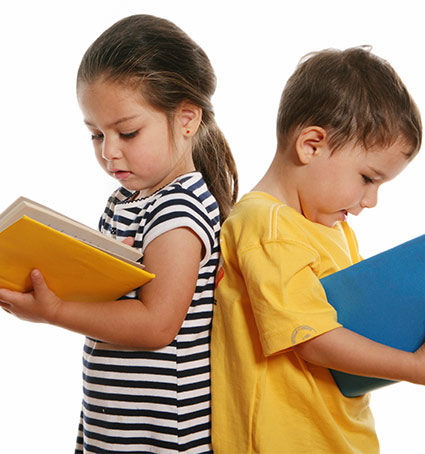1. What is a Montessori school?
A Montessori environment respects and values the whole child and seeks to foster within them a sense of independence, empowerment, and strong communication skills. Self-paced (or self-directed) learning means that a child is free to explore materials that interest them, either alone or with others, at a pace that is developmentally appropriate for that individual. Goals of the Montessori environment include developing an intrinsic motivation to complete a task fully and successfully without rewards or fear. Other key elements of a Montessori classroom include global awareness, social responsibility, leadership, and respect.
2. Why are Montessori classrooms multi-age?
Montessori classes are comprised of three-year age spans. In a multi-age classroom, students can learn from those younger and older than them, and develop social skills from working in these mixed age groups. This is a wonderful opportunity for collaboration and teamwork. It also gives students the chance to develop empathy from others, and gain and demonstrate leadership skills. Montessori classrooms can begin at infancy and range up to the equivalent of grade 12. They are divided up as follows, by ages: 0-3, 3-6, 6-9, 9-12, 12-15, and 15-18.
3. What materials are used in a Montessori classroom? How are they different from those in other learning environments?
Montessori materials are traditionally made from natural products and elements, intended to stimulate the student's brain in a way that does not create sensory overload. There are typical traditional Montessori materials, ones that can be found in every true Montessori classroom. In a three to six year old classroom, some of these include materials with unusual names such as the Dressing Frames, the Cylinder Blocks, the Pink Tower, the Brown Stair, the Red Rods, the Number Rods, the Knobless Cylinders, the Sandpaper Letters, the Movable Alphabet...and the list goes on. Although plastic materials make their way into modern a Montessori classroom, the idea is that natural products are the primary learning tools and focus for instruction.
4. Why doesn't a Montessori teacher grade students?
The teacher's primary role is to design an engaging environment. Teachers modelappropriate classroom behavior, keep diligent records on each child, guide the students, and most importantly, observe. Grades in the form of letters or percentages only focus on results. This is not a true measure of what the student knows at a particular moment in time. When grades are applied, they become the focus of a task rather than encourage a love of learning. The process of learning is a fluctuating curve and it is through this broad, complex procedure that a child experiences mistakes, corrections, and the successful completion of tasks. Instead of grades, a Montessori teacher provides descriptive reports on what a child's focus of interest is and the progress. Social development is as important as academic accomplishment.
5. Why should I enroll my child in a Montessori preschool and kindergarten program?
The Montessori environment is a student-centred environment. Students' interests and development level are paramount in the classroom, and therefore it is designed to engage them and meet their unique needs. There are opportunities for individual and small group work, as well as whole class activity. The individual and small group lessons mean that your child receives the intimate and attentive guidance they need to be successful. While there are classroom rules and routines, the child is free to explore the classroom and materials as they wish (we call this "freedom within limits"). Students learn to become independent in their day-to-day tasks, critical thinkers, creative, and collaborative with their peers.
6. Will my child successfully integrate into other learning environments that are not Montessori-based?
Children who attend Montessori programs are typically very adaptive to new situations. This is due to the fact that they are taught from a young age to communicate, exchange ideas, and work independently. These skills mean that often children can successfully navigate their way in unfamiliar settings because they feel empowered to express themselves, ask questions, and embrace new challenges. The key to adaptation is self-confidence, a trait Montessori teachers work to instill in every child they teach.

